St Barbara Limited Business Report
VerifiedAdded on 2019/11/20
|17
|4275
|169
Report
AI Summary
This report provides a detailed analysis of St Barbara Limited, an Australian gold mining company. It covers various aspects of the business, including an executive summary, introduction to the company's nature and operations, a review of the legal environment in Australia, and an in-depth examination of external environmental factors. The report utilizes PEST analysis, Porter's Five Forces model, and SWOT analysis to assess the company's position and potential. It also delves into the company's objectives, strategies, risk assessment, analytical procedures, business management and governance, including management philosophies (Theory X and Y, single-loop and double-loop learning), and corporate governance frameworks in Australia. The conclusion summarizes the company's focus on growth, its commitment to employee equality, and the importance of employee participation in decision-making. The report includes a comprehensive list of references.

Auditing 1
Auditing
Auditing
Paraphrase This Document
Need a fresh take? Get an instant paraphrase of this document with our AI Paraphraser
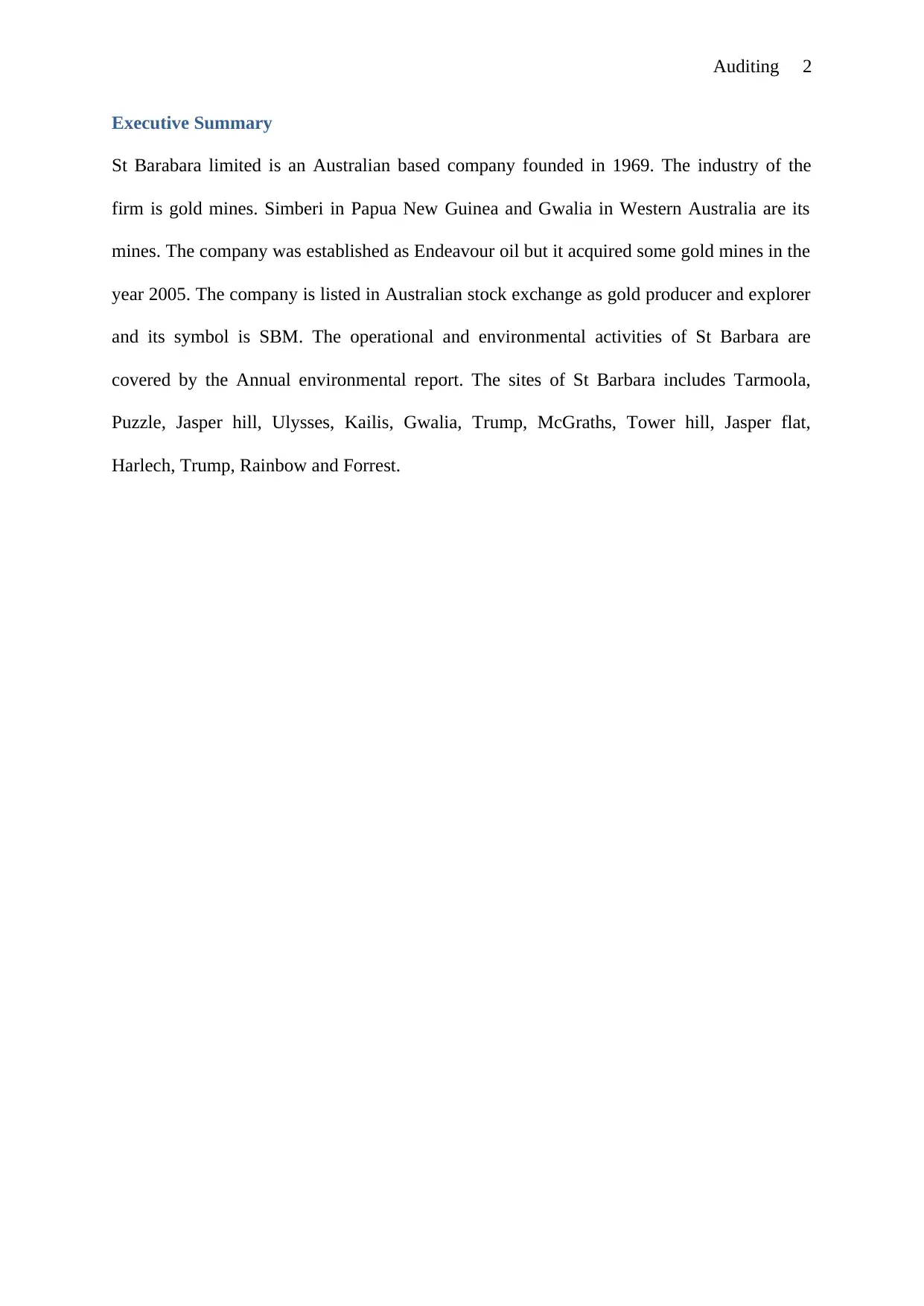
Auditing 2
Executive Summary
St Barabara limited is an Australian based company founded in 1969. The industry of the
firm is gold mines. Simberi in Papua New Guinea and Gwalia in Western Australia are its
mines. The company was established as Endeavour oil but it acquired some gold mines in the
year 2005. The company is listed in Australian stock exchange as gold producer and explorer
and its symbol is SBM. The operational and environmental activities of St Barbara are
covered by the Annual environmental report. The sites of St Barbara includes Tarmoola,
Puzzle, Jasper hill, Ulysses, Kailis, Gwalia, Trump, McGraths, Tower hill, Jasper flat,
Harlech, Trump, Rainbow and Forrest.
Executive Summary
St Barabara limited is an Australian based company founded in 1969. The industry of the
firm is gold mines. Simberi in Papua New Guinea and Gwalia in Western Australia are its
mines. The company was established as Endeavour oil but it acquired some gold mines in the
year 2005. The company is listed in Australian stock exchange as gold producer and explorer
and its symbol is SBM. The operational and environmental activities of St Barbara are
covered by the Annual environmental report. The sites of St Barbara includes Tarmoola,
Puzzle, Jasper hill, Ulysses, Kailis, Gwalia, Trump, McGraths, Tower hill, Jasper flat,
Harlech, Trump, Rainbow and Forrest.
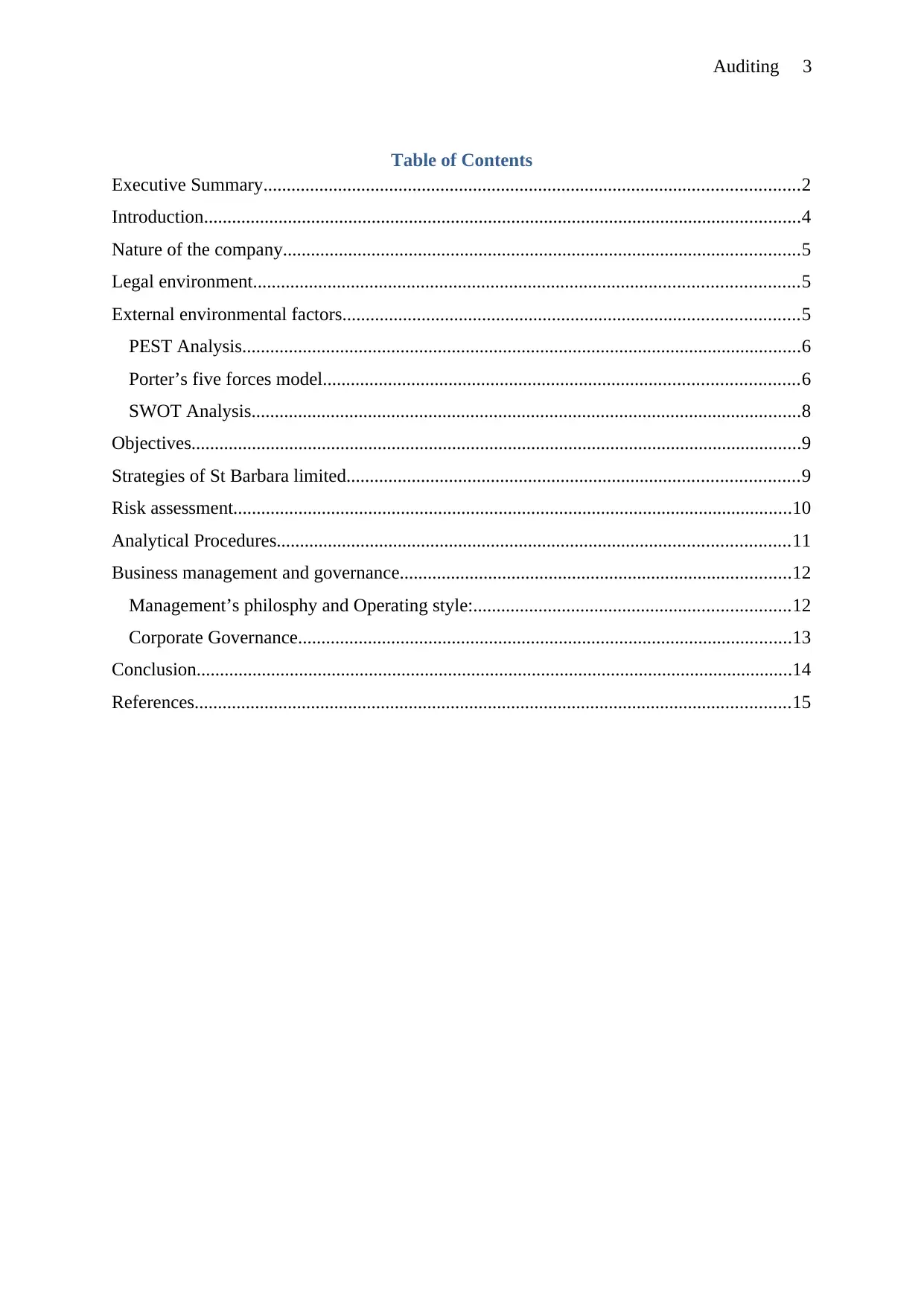
Auditing 3
Table of Contents
Executive Summary...................................................................................................................2
Introduction................................................................................................................................4
Nature of the company...............................................................................................................5
Legal environment.....................................................................................................................5
External environmental factors..................................................................................................5
PEST Analysis........................................................................................................................6
Porter’s five forces model......................................................................................................6
SWOT Analysis......................................................................................................................8
Objectives...................................................................................................................................9
Strategies of St Barbara limited.................................................................................................9
Risk assessment........................................................................................................................10
Analytical Procedures..............................................................................................................11
Business management and governance....................................................................................12
Management’s philosphy and Operating style:....................................................................12
Corporate Governance..........................................................................................................13
Conclusion................................................................................................................................14
References................................................................................................................................15
Table of Contents
Executive Summary...................................................................................................................2
Introduction................................................................................................................................4
Nature of the company...............................................................................................................5
Legal environment.....................................................................................................................5
External environmental factors..................................................................................................5
PEST Analysis........................................................................................................................6
Porter’s five forces model......................................................................................................6
SWOT Analysis......................................................................................................................8
Objectives...................................................................................................................................9
Strategies of St Barbara limited.................................................................................................9
Risk assessment........................................................................................................................10
Analytical Procedures..............................................................................................................11
Business management and governance....................................................................................12
Management’s philosphy and Operating style:....................................................................12
Corporate Governance..........................................................................................................13
Conclusion................................................................................................................................14
References................................................................................................................................15
⊘ This is a preview!⊘
Do you want full access?
Subscribe today to unlock all pages.

Trusted by 1+ million students worldwide
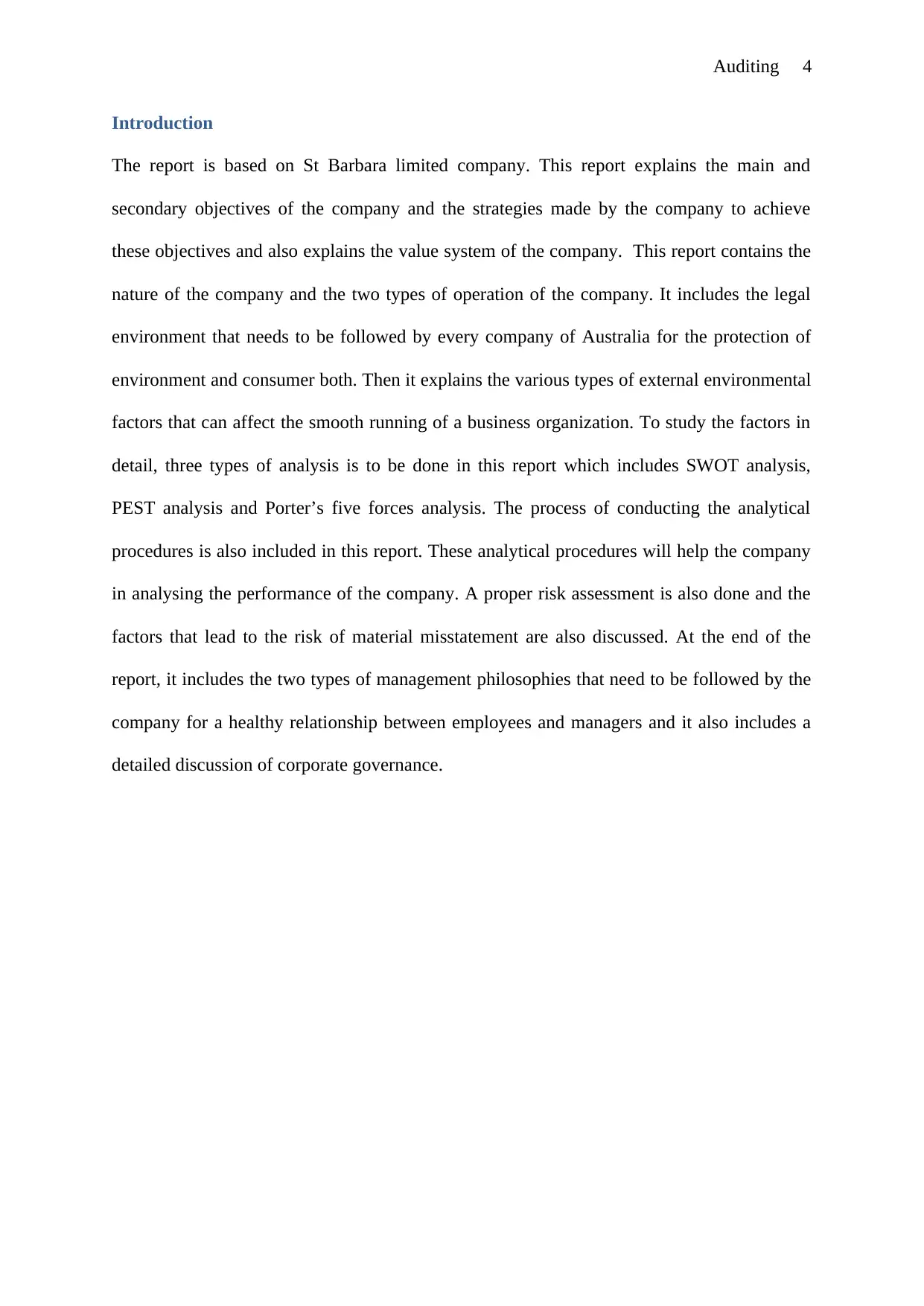
Auditing 4
Introduction
The report is based on St Barbara limited company. This report explains the main and
secondary objectives of the company and the strategies made by the company to achieve
these objectives and also explains the value system of the company. This report contains the
nature of the company and the two types of operation of the company. It includes the legal
environment that needs to be followed by every company of Australia for the protection of
environment and consumer both. Then it explains the various types of external environmental
factors that can affect the smooth running of a business organization. To study the factors in
detail, three types of analysis is to be done in this report which includes SWOT analysis,
PEST analysis and Porter’s five forces analysis. The process of conducting the analytical
procedures is also included in this report. These analytical procedures will help the company
in analysing the performance of the company. A proper risk assessment is also done and the
factors that lead to the risk of material misstatement are also discussed. At the end of the
report, it includes the two types of management philosophies that need to be followed by the
company for a healthy relationship between employees and managers and it also includes a
detailed discussion of corporate governance.
Introduction
The report is based on St Barbara limited company. This report explains the main and
secondary objectives of the company and the strategies made by the company to achieve
these objectives and also explains the value system of the company. This report contains the
nature of the company and the two types of operation of the company. It includes the legal
environment that needs to be followed by every company of Australia for the protection of
environment and consumer both. Then it explains the various types of external environmental
factors that can affect the smooth running of a business organization. To study the factors in
detail, three types of analysis is to be done in this report which includes SWOT analysis,
PEST analysis and Porter’s five forces analysis. The process of conducting the analytical
procedures is also included in this report. These analytical procedures will help the company
in analysing the performance of the company. A proper risk assessment is also done and the
factors that lead to the risk of material misstatement are also discussed. At the end of the
report, it includes the two types of management philosophies that need to be followed by the
company for a healthy relationship between employees and managers and it also includes a
detailed discussion of corporate governance.
Paraphrase This Document
Need a fresh take? Get an instant paraphrase of this document with our AI Paraphraser
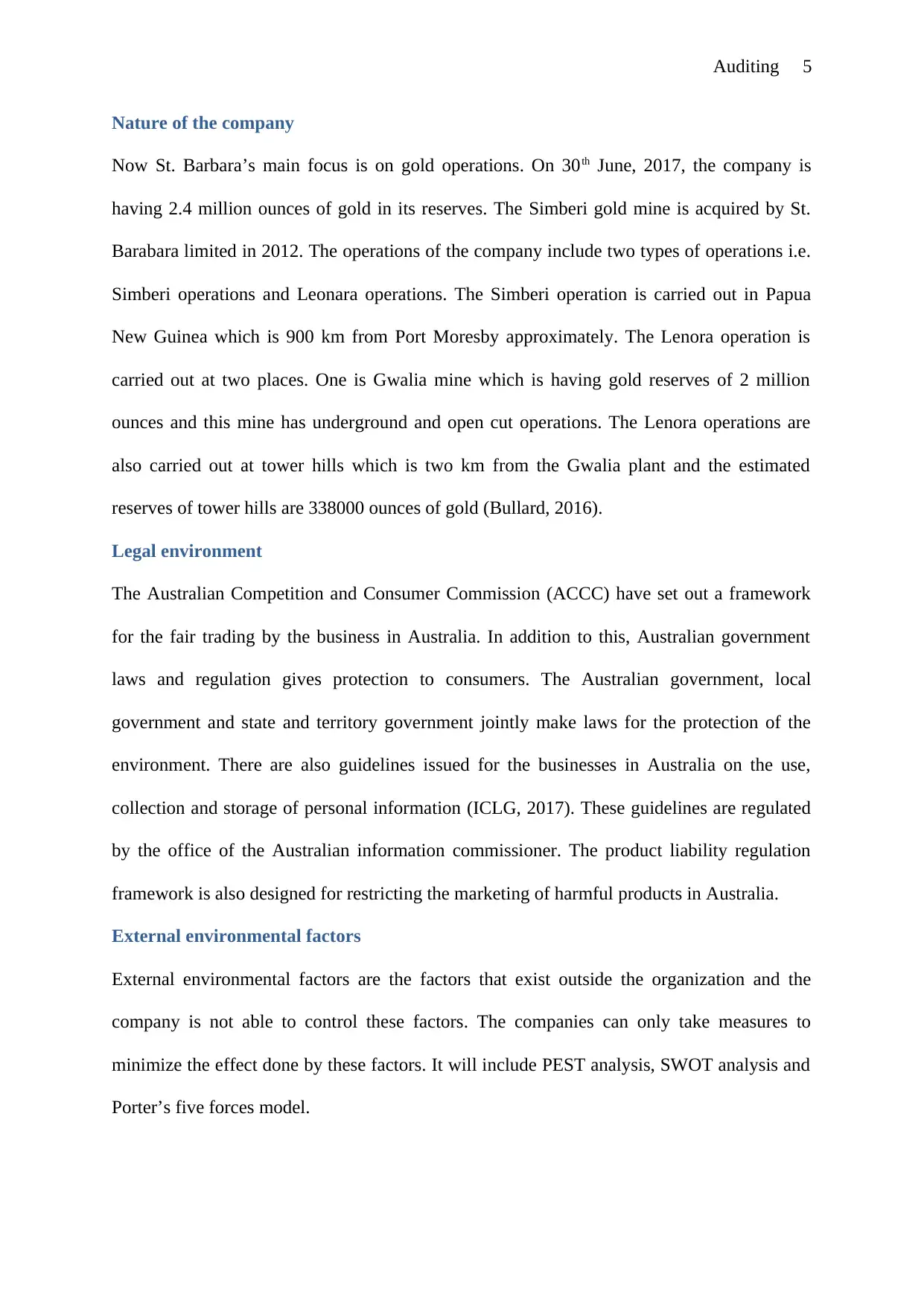
Auditing 5
Nature of the company
Now St. Barbara’s main focus is on gold operations. On 30th June, 2017, the company is
having 2.4 million ounces of gold in its reserves. The Simberi gold mine is acquired by St.
Barabara limited in 2012. The operations of the company include two types of operations i.e.
Simberi operations and Leonara operations. The Simberi operation is carried out in Papua
New Guinea which is 900 km from Port Moresby approximately. The Lenora operation is
carried out at two places. One is Gwalia mine which is having gold reserves of 2 million
ounces and this mine has underground and open cut operations. The Lenora operations are
also carried out at tower hills which is two km from the Gwalia plant and the estimated
reserves of tower hills are 338000 ounces of gold (Bullard, 2016).
Legal environment
The Australian Competition and Consumer Commission (ACCC) have set out a framework
for the fair trading by the business in Australia. In addition to this, Australian government
laws and regulation gives protection to consumers. The Australian government, local
government and state and territory government jointly make laws for the protection of the
environment. There are also guidelines issued for the businesses in Australia on the use,
collection and storage of personal information (ICLG, 2017). These guidelines are regulated
by the office of the Australian information commissioner. The product liability regulation
framework is also designed for restricting the marketing of harmful products in Australia.
External environmental factors
External environmental factors are the factors that exist outside the organization and the
company is not able to control these factors. The companies can only take measures to
minimize the effect done by these factors. It will include PEST analysis, SWOT analysis and
Porter’s five forces model.
Nature of the company
Now St. Barbara’s main focus is on gold operations. On 30th June, 2017, the company is
having 2.4 million ounces of gold in its reserves. The Simberi gold mine is acquired by St.
Barabara limited in 2012. The operations of the company include two types of operations i.e.
Simberi operations and Leonara operations. The Simberi operation is carried out in Papua
New Guinea which is 900 km from Port Moresby approximately. The Lenora operation is
carried out at two places. One is Gwalia mine which is having gold reserves of 2 million
ounces and this mine has underground and open cut operations. The Lenora operations are
also carried out at tower hills which is two km from the Gwalia plant and the estimated
reserves of tower hills are 338000 ounces of gold (Bullard, 2016).
Legal environment
The Australian Competition and Consumer Commission (ACCC) have set out a framework
for the fair trading by the business in Australia. In addition to this, Australian government
laws and regulation gives protection to consumers. The Australian government, local
government and state and territory government jointly make laws for the protection of the
environment. There are also guidelines issued for the businesses in Australia on the use,
collection and storage of personal information (ICLG, 2017). These guidelines are regulated
by the office of the Australian information commissioner. The product liability regulation
framework is also designed for restricting the marketing of harmful products in Australia.
External environmental factors
External environmental factors are the factors that exist outside the organization and the
company is not able to control these factors. The companies can only take measures to
minimize the effect done by these factors. It will include PEST analysis, SWOT analysis and
Porter’s five forces model.
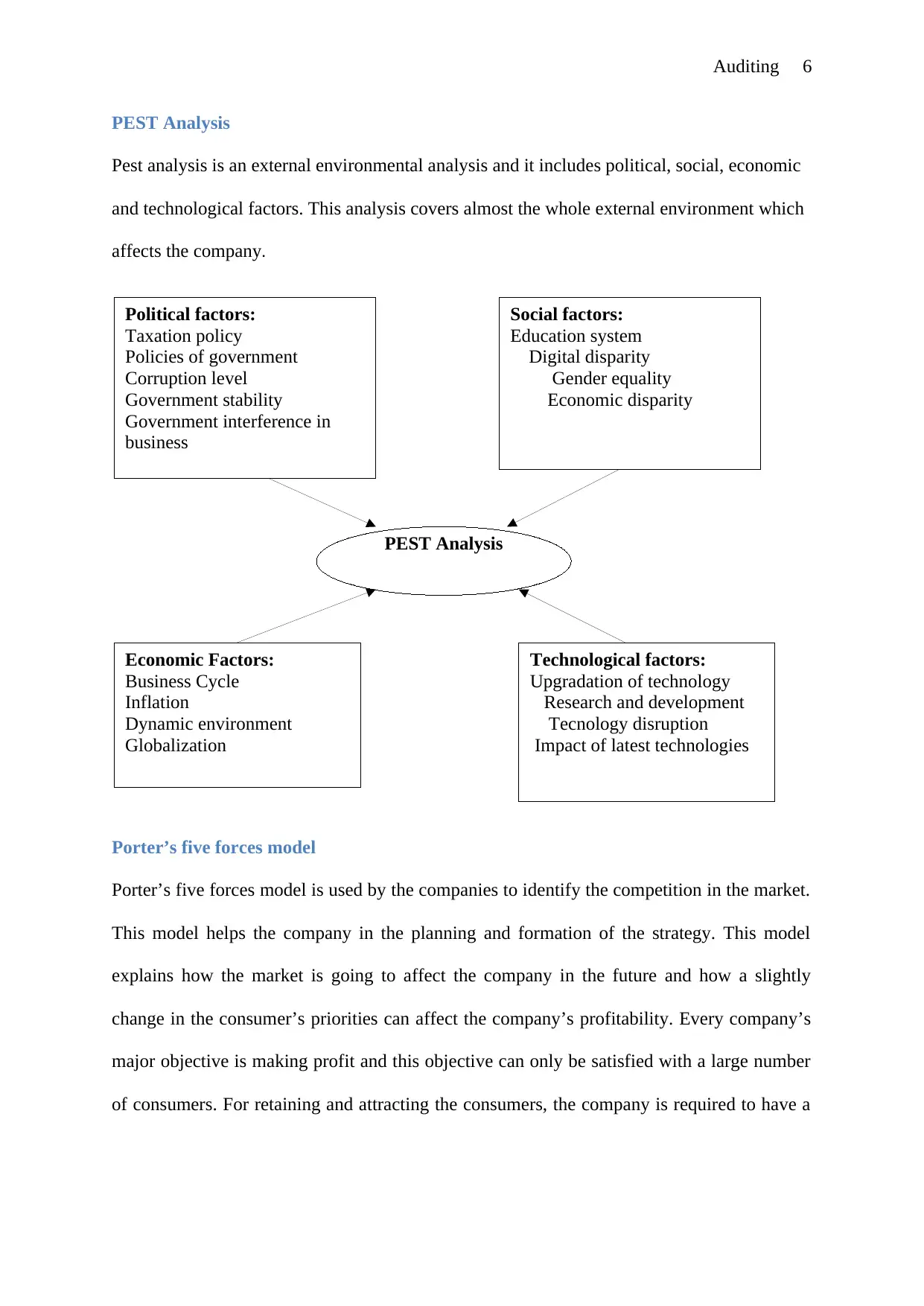
Political factors:
Taxation policy
Policies of government
Corruption level
Government stability
Government interference in
business
Social factors:
Education system
Digital disparity
Gender equality
Economic disparity
Economic Factors:
Business Cycle
Inflation
Dynamic environment
Globalization
Technological factors:
Upgradation of technology
Research and development
Tecnology disruption
Impact of latest technologies
PEST Analysis
Auditing 6
PEST Analysis
Pest analysis is an external environmental analysis and it includes political, social, economic
and technological factors. This analysis covers almost the whole external environment which
affects the company.
Porter’s five forces model
Porter’s five forces model is used by the companies to identify the competition in the market.
This model helps the company in the planning and formation of the strategy. This model
explains how the market is going to affect the company in the future and how a slightly
change in the consumer’s priorities can affect the company’s profitability. Every company’s
major objective is making profit and this objective can only be satisfied with a large number
of consumers. For retaining and attracting the consumers, the company is required to have a
Taxation policy
Policies of government
Corruption level
Government stability
Government interference in
business
Social factors:
Education system
Digital disparity
Gender equality
Economic disparity
Economic Factors:
Business Cycle
Inflation
Dynamic environment
Globalization
Technological factors:
Upgradation of technology
Research and development
Tecnology disruption
Impact of latest technologies
PEST Analysis
Auditing 6
PEST Analysis
Pest analysis is an external environmental analysis and it includes political, social, economic
and technological factors. This analysis covers almost the whole external environment which
affects the company.
Porter’s five forces model
Porter’s five forces model is used by the companies to identify the competition in the market.
This model helps the company in the planning and formation of the strategy. This model
explains how the market is going to affect the company in the future and how a slightly
change in the consumer’s priorities can affect the company’s profitability. Every company’s
major objective is making profit and this objective can only be satisfied with a large number
of consumers. For retaining and attracting the consumers, the company is required to have a
⊘ This is a preview!⊘
Do you want full access?
Subscribe today to unlock all pages.

Trusted by 1+ million students worldwide
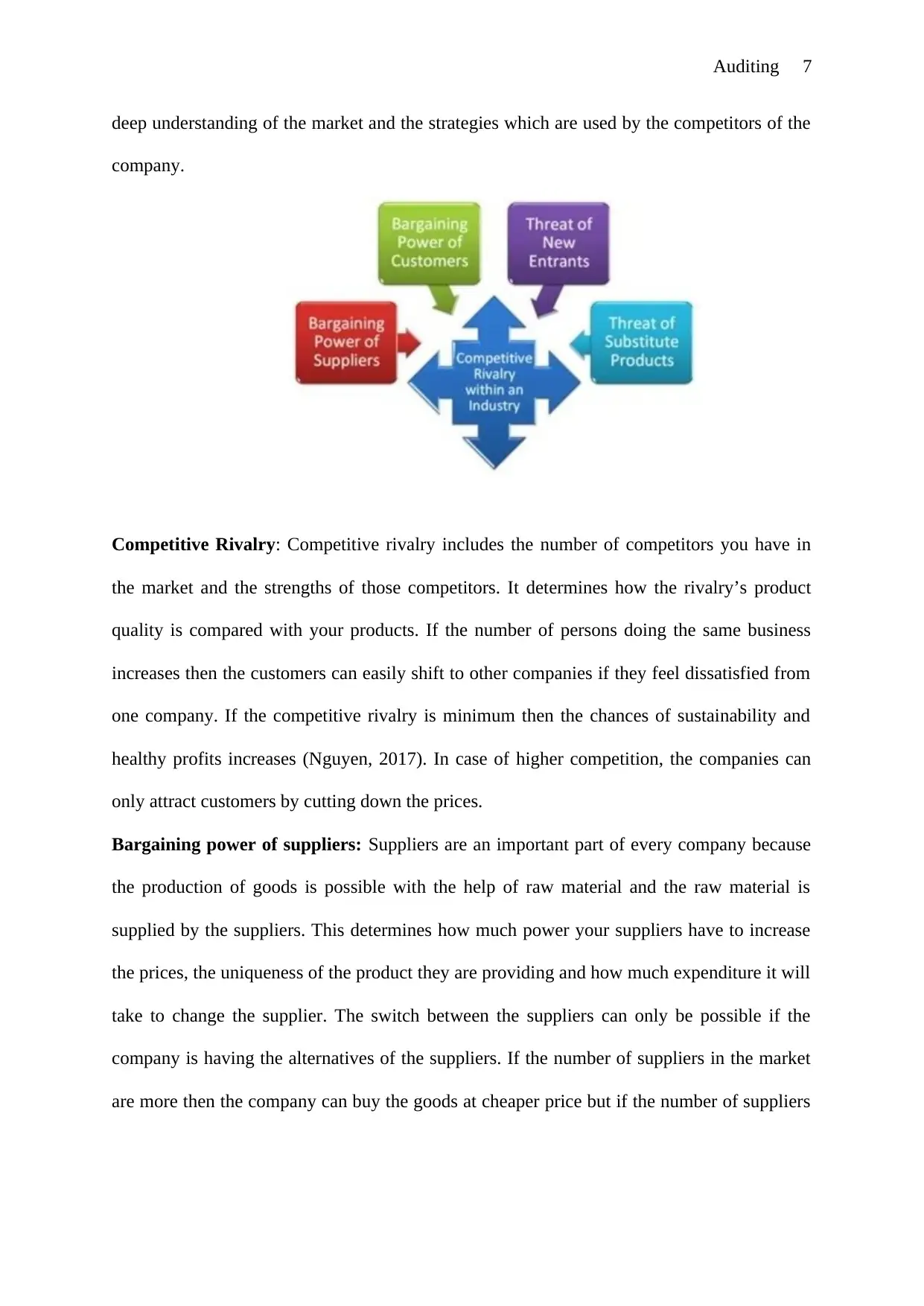
Auditing 7
deep understanding of the market and the strategies which are used by the competitors of the
company.
Competitive Rivalry: Competitive rivalry includes the number of competitors you have in
the market and the strengths of those competitors. It determines how the rivalry’s product
quality is compared with your products. If the number of persons doing the same business
increases then the customers can easily shift to other companies if they feel dissatisfied from
one company. If the competitive rivalry is minimum then the chances of sustainability and
healthy profits increases (Nguyen, 2017). In case of higher competition, the companies can
only attract customers by cutting down the prices.
Bargaining power of suppliers: Suppliers are an important part of every company because
the production of goods is possible with the help of raw material and the raw material is
supplied by the suppliers. This determines how much power your suppliers have to increase
the prices, the uniqueness of the product they are providing and how much expenditure it will
take to change the supplier. The switch between the suppliers can only be possible if the
company is having the alternatives of the suppliers. If the number of suppliers in the market
are more then the company can buy the goods at cheaper price but if the number of suppliers
deep understanding of the market and the strategies which are used by the competitors of the
company.
Competitive Rivalry: Competitive rivalry includes the number of competitors you have in
the market and the strengths of those competitors. It determines how the rivalry’s product
quality is compared with your products. If the number of persons doing the same business
increases then the customers can easily shift to other companies if they feel dissatisfied from
one company. If the competitive rivalry is minimum then the chances of sustainability and
healthy profits increases (Nguyen, 2017). In case of higher competition, the companies can
only attract customers by cutting down the prices.
Bargaining power of suppliers: Suppliers are an important part of every company because
the production of goods is possible with the help of raw material and the raw material is
supplied by the suppliers. This determines how much power your suppliers have to increase
the prices, the uniqueness of the product they are providing and how much expenditure it will
take to change the supplier. The switch between the suppliers can only be possible if the
company is having the alternatives of the suppliers. If the number of suppliers in the market
are more then the company can buy the goods at cheaper price but if the number of suppliers
Paraphrase This Document
Need a fresh take? Get an instant paraphrase of this document with our AI Paraphraser
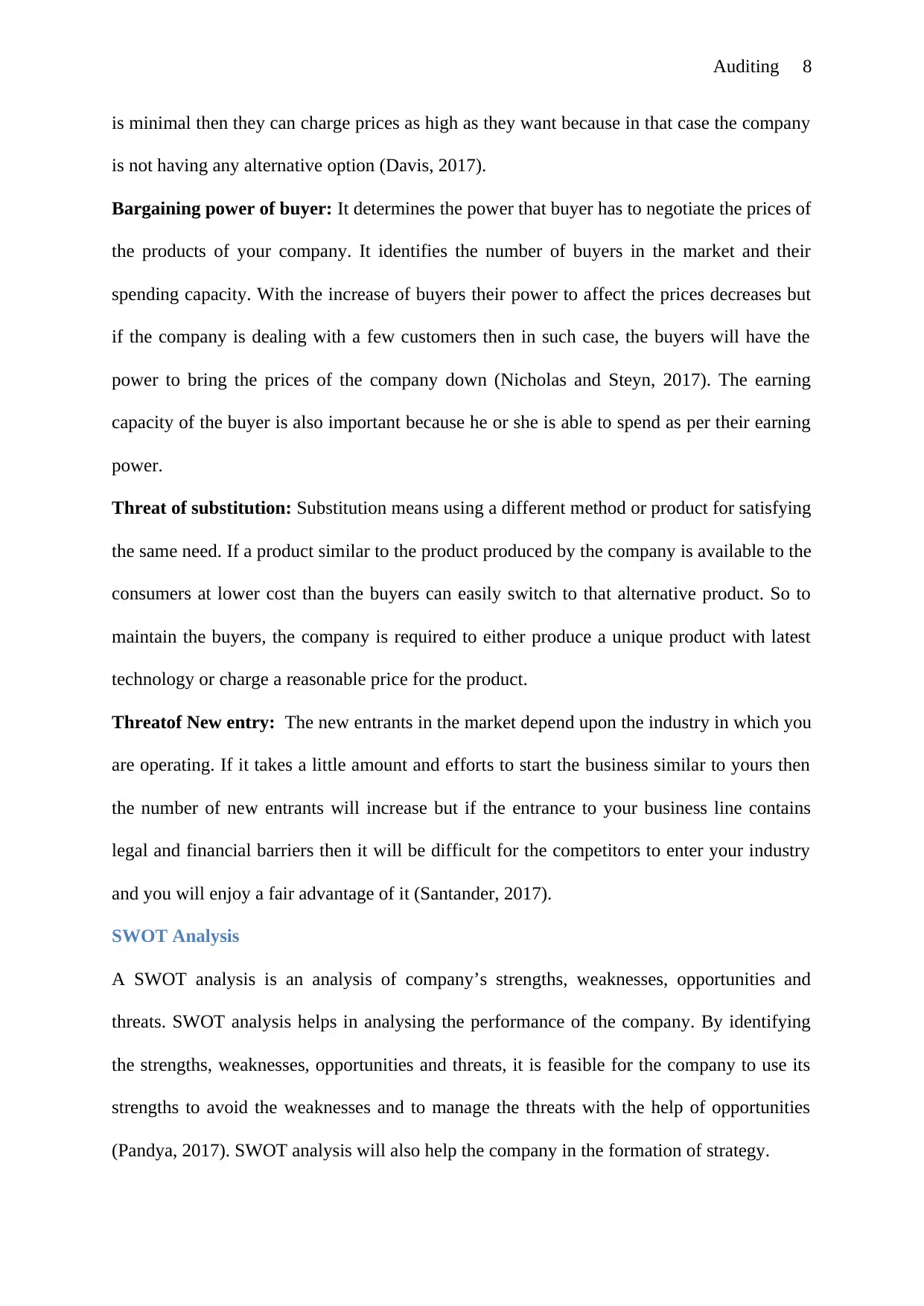
Auditing 8
is minimal then they can charge prices as high as they want because in that case the company
is not having any alternative option (Davis, 2017).
Bargaining power of buyer: It determines the power that buyer has to negotiate the prices of
the products of your company. It identifies the number of buyers in the market and their
spending capacity. With the increase of buyers their power to affect the prices decreases but
if the company is dealing with a few customers then in such case, the buyers will have the
power to bring the prices of the company down (Nicholas and Steyn, 2017). The earning
capacity of the buyer is also important because he or she is able to spend as per their earning
power.
Threat of substitution: Substitution means using a different method or product for satisfying
the same need. If a product similar to the product produced by the company is available to the
consumers at lower cost than the buyers can easily switch to that alternative product. So to
maintain the buyers, the company is required to either produce a unique product with latest
technology or charge a reasonable price for the product.
Threatof New entry: The new entrants in the market depend upon the industry in which you
are operating. If it takes a little amount and efforts to start the business similar to yours then
the number of new entrants will increase but if the entrance to your business line contains
legal and financial barriers then it will be difficult for the competitors to enter your industry
and you will enjoy a fair advantage of it (Santander, 2017).
SWOT Analysis
A SWOT analysis is an analysis of company’s strengths, weaknesses, opportunities and
threats. SWOT analysis helps in analysing the performance of the company. By identifying
the strengths, weaknesses, opportunities and threats, it is feasible for the company to use its
strengths to avoid the weaknesses and to manage the threats with the help of opportunities
(Pandya, 2017). SWOT analysis will also help the company in the formation of strategy.
is minimal then they can charge prices as high as they want because in that case the company
is not having any alternative option (Davis, 2017).
Bargaining power of buyer: It determines the power that buyer has to negotiate the prices of
the products of your company. It identifies the number of buyers in the market and their
spending capacity. With the increase of buyers their power to affect the prices decreases but
if the company is dealing with a few customers then in such case, the buyers will have the
power to bring the prices of the company down (Nicholas and Steyn, 2017). The earning
capacity of the buyer is also important because he or she is able to spend as per their earning
power.
Threat of substitution: Substitution means using a different method or product for satisfying
the same need. If a product similar to the product produced by the company is available to the
consumers at lower cost than the buyers can easily switch to that alternative product. So to
maintain the buyers, the company is required to either produce a unique product with latest
technology or charge a reasonable price for the product.
Threatof New entry: The new entrants in the market depend upon the industry in which you
are operating. If it takes a little amount and efforts to start the business similar to yours then
the number of new entrants will increase but if the entrance to your business line contains
legal and financial barriers then it will be difficult for the competitors to enter your industry
and you will enjoy a fair advantage of it (Santander, 2017).
SWOT Analysis
A SWOT analysis is an analysis of company’s strengths, weaknesses, opportunities and
threats. SWOT analysis helps in analysing the performance of the company. By identifying
the strengths, weaknesses, opportunities and threats, it is feasible for the company to use its
strengths to avoid the weaknesses and to manage the threats with the help of opportunities
(Pandya, 2017). SWOT analysis will also help the company in the formation of strategy.
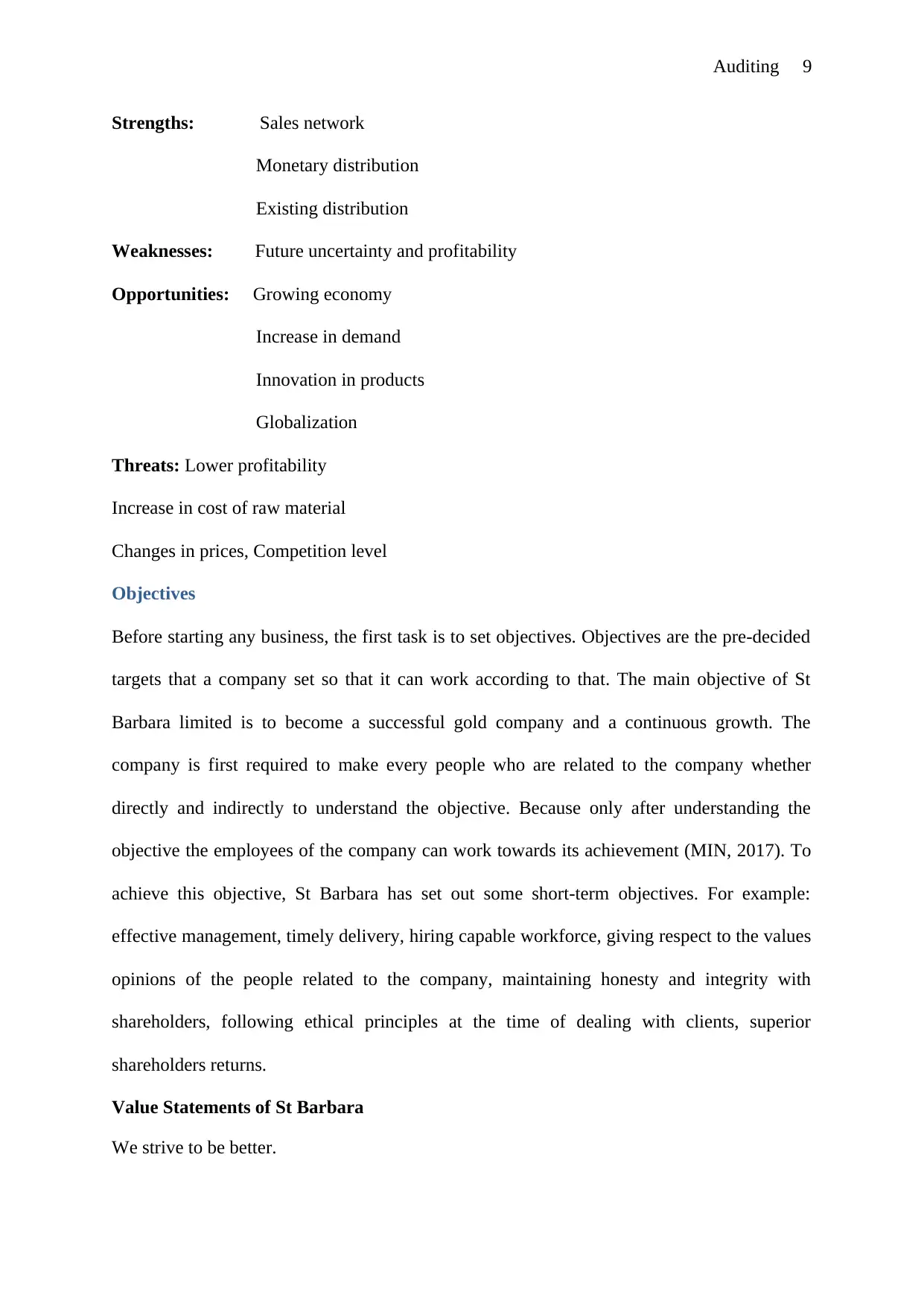
Auditing 9
Strengths: Sales network
Monetary distribution
Existing distribution
Weaknesses: Future uncertainty and profitability
Opportunities: Growing economy
Increase in demand
Innovation in products
Globalization
Threats: Lower profitability
Increase in cost of raw material
Changes in prices, Competition level
Objectives
Before starting any business, the first task is to set objectives. Objectives are the pre-decided
targets that a company set so that it can work according to that. The main objective of St
Barbara limited is to become a successful gold company and a continuous growth. The
company is first required to make every people who are related to the company whether
directly and indirectly to understand the objective. Because only after understanding the
objective the employees of the company can work towards its achievement (MIN, 2017). To
achieve this objective, St Barbara has set out some short-term objectives. For example:
effective management, timely delivery, hiring capable workforce, giving respect to the values
opinions of the people related to the company, maintaining honesty and integrity with
shareholders, following ethical principles at the time of dealing with clients, superior
shareholders returns.
Value Statements of St Barbara
We strive to be better.
Strengths: Sales network
Monetary distribution
Existing distribution
Weaknesses: Future uncertainty and profitability
Opportunities: Growing economy
Increase in demand
Innovation in products
Globalization
Threats: Lower profitability
Increase in cost of raw material
Changes in prices, Competition level
Objectives
Before starting any business, the first task is to set objectives. Objectives are the pre-decided
targets that a company set so that it can work according to that. The main objective of St
Barbara limited is to become a successful gold company and a continuous growth. The
company is first required to make every people who are related to the company whether
directly and indirectly to understand the objective. Because only after understanding the
objective the employees of the company can work towards its achievement (MIN, 2017). To
achieve this objective, St Barbara has set out some short-term objectives. For example:
effective management, timely delivery, hiring capable workforce, giving respect to the values
opinions of the people related to the company, maintaining honesty and integrity with
shareholders, following ethical principles at the time of dealing with clients, superior
shareholders returns.
Value Statements of St Barbara
We strive to be better.
⊘ This is a preview!⊘
Do you want full access?
Subscribe today to unlock all pages.

Trusted by 1+ million students worldwide
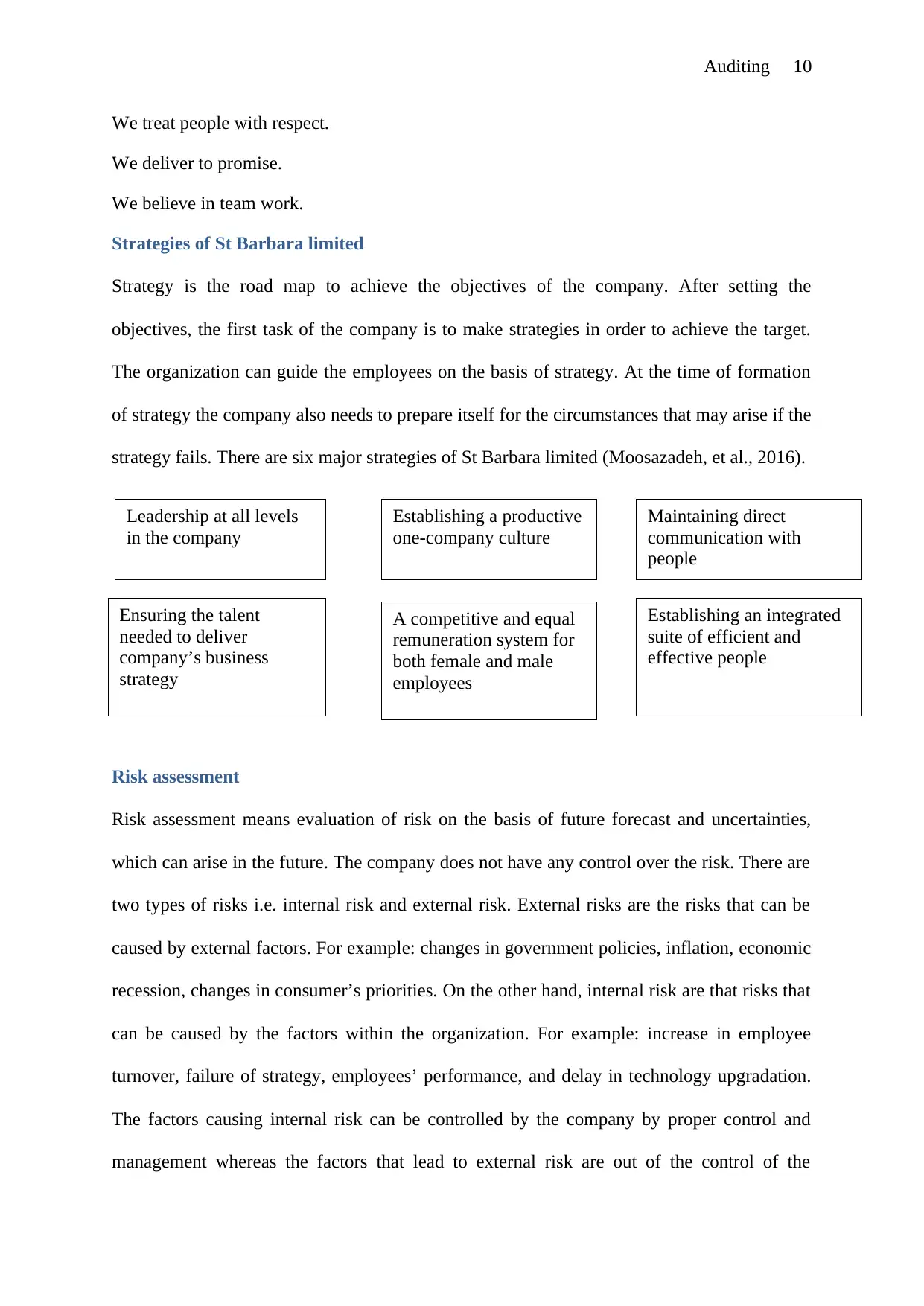
Leadership at all levels
in the company
Establishing a productive
one-company culture
Maintaining direct
communication with
people
Ensuring the talent
needed to deliver
company’s business
strategy
A competitive and equal
remuneration system for
both female and male
employees
Establishing an integrated
suite of efficient and
effective people
Auditing 10
We treat people with respect.
We deliver to promise.
We believe in team work.
Strategies of St Barbara limited
Strategy is the road map to achieve the objectives of the company. After setting the
objectives, the first task of the company is to make strategies in order to achieve the target.
The organization can guide the employees on the basis of strategy. At the time of formation
of strategy the company also needs to prepare itself for the circumstances that may arise if the
strategy fails. There are six major strategies of St Barbara limited (Moosazadeh, et al., 2016).
Risk assessment
Risk assessment means evaluation of risk on the basis of future forecast and uncertainties,
which can arise in the future. The company does not have any control over the risk. There are
two types of risks i.e. internal risk and external risk. External risks are the risks that can be
caused by external factors. For example: changes in government policies, inflation, economic
recession, changes in consumer’s priorities. On the other hand, internal risk are that risks that
can be caused by the factors within the organization. For example: increase in employee
turnover, failure of strategy, employees’ performance, and delay in technology upgradation.
The factors causing internal risk can be controlled by the company by proper control and
management whereas the factors that lead to external risk are out of the control of the
in the company
Establishing a productive
one-company culture
Maintaining direct
communication with
people
Ensuring the talent
needed to deliver
company’s business
strategy
A competitive and equal
remuneration system for
both female and male
employees
Establishing an integrated
suite of efficient and
effective people
Auditing 10
We treat people with respect.
We deliver to promise.
We believe in team work.
Strategies of St Barbara limited
Strategy is the road map to achieve the objectives of the company. After setting the
objectives, the first task of the company is to make strategies in order to achieve the target.
The organization can guide the employees on the basis of strategy. At the time of formation
of strategy the company also needs to prepare itself for the circumstances that may arise if the
strategy fails. There are six major strategies of St Barbara limited (Moosazadeh, et al., 2016).
Risk assessment
Risk assessment means evaluation of risk on the basis of future forecast and uncertainties,
which can arise in the future. The company does not have any control over the risk. There are
two types of risks i.e. internal risk and external risk. External risks are the risks that can be
caused by external factors. For example: changes in government policies, inflation, economic
recession, changes in consumer’s priorities. On the other hand, internal risk are that risks that
can be caused by the factors within the organization. For example: increase in employee
turnover, failure of strategy, employees’ performance, and delay in technology upgradation.
The factors causing internal risk can be controlled by the company by proper control and
management whereas the factors that lead to external risk are out of the control of the
Paraphrase This Document
Need a fresh take? Get an instant paraphrase of this document with our AI Paraphraser
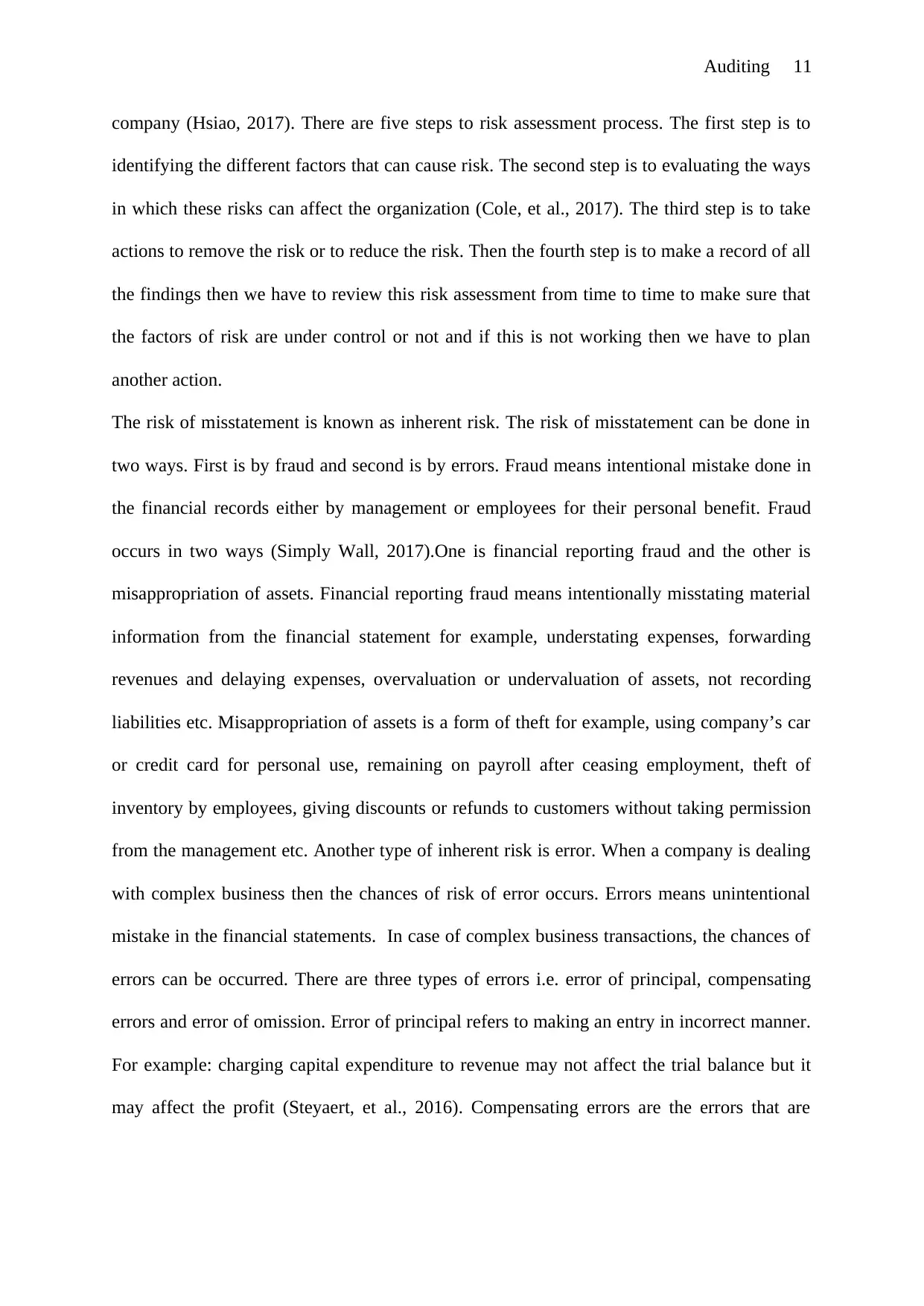
Auditing 11
company (Hsiao, 2017). There are five steps to risk assessment process. The first step is to
identifying the different factors that can cause risk. The second step is to evaluating the ways
in which these risks can affect the organization (Cole, et al., 2017). The third step is to take
actions to remove the risk or to reduce the risk. Then the fourth step is to make a record of all
the findings then we have to review this risk assessment from time to time to make sure that
the factors of risk are under control or not and if this is not working then we have to plan
another action.
The risk of misstatement is known as inherent risk. The risk of misstatement can be done in
two ways. First is by fraud and second is by errors. Fraud means intentional mistake done in
the financial records either by management or employees for their personal benefit. Fraud
occurs in two ways (Simply Wall, 2017).One is financial reporting fraud and the other is
misappropriation of assets. Financial reporting fraud means intentionally misstating material
information from the financial statement for example, understating expenses, forwarding
revenues and delaying expenses, overvaluation or undervaluation of assets, not recording
liabilities etc. Misappropriation of assets is a form of theft for example, using company’s car
or credit card for personal use, remaining on payroll after ceasing employment, theft of
inventory by employees, giving discounts or refunds to customers without taking permission
from the management etc. Another type of inherent risk is error. When a company is dealing
with complex business then the chances of risk of error occurs. Errors means unintentional
mistake in the financial statements. In case of complex business transactions, the chances of
errors can be occurred. There are three types of errors i.e. error of principal, compensating
errors and error of omission. Error of principal refers to making an entry in incorrect manner.
For example: charging capital expenditure to revenue may not affect the trial balance but it
may affect the profit (Steyaert, et al., 2016). Compensating errors are the errors that are
company (Hsiao, 2017). There are five steps to risk assessment process. The first step is to
identifying the different factors that can cause risk. The second step is to evaluating the ways
in which these risks can affect the organization (Cole, et al., 2017). The third step is to take
actions to remove the risk or to reduce the risk. Then the fourth step is to make a record of all
the findings then we have to review this risk assessment from time to time to make sure that
the factors of risk are under control or not and if this is not working then we have to plan
another action.
The risk of misstatement is known as inherent risk. The risk of misstatement can be done in
two ways. First is by fraud and second is by errors. Fraud means intentional mistake done in
the financial records either by management or employees for their personal benefit. Fraud
occurs in two ways (Simply Wall, 2017).One is financial reporting fraud and the other is
misappropriation of assets. Financial reporting fraud means intentionally misstating material
information from the financial statement for example, understating expenses, forwarding
revenues and delaying expenses, overvaluation or undervaluation of assets, not recording
liabilities etc. Misappropriation of assets is a form of theft for example, using company’s car
or credit card for personal use, remaining on payroll after ceasing employment, theft of
inventory by employees, giving discounts or refunds to customers without taking permission
from the management etc. Another type of inherent risk is error. When a company is dealing
with complex business then the chances of risk of error occurs. Errors means unintentional
mistake in the financial statements. In case of complex business transactions, the chances of
errors can be occurred. There are three types of errors i.e. error of principal, compensating
errors and error of omission. Error of principal refers to making an entry in incorrect manner.
For example: charging capital expenditure to revenue may not affect the trial balance but it
may affect the profit (Steyaert, et al., 2016). Compensating errors are the errors that are
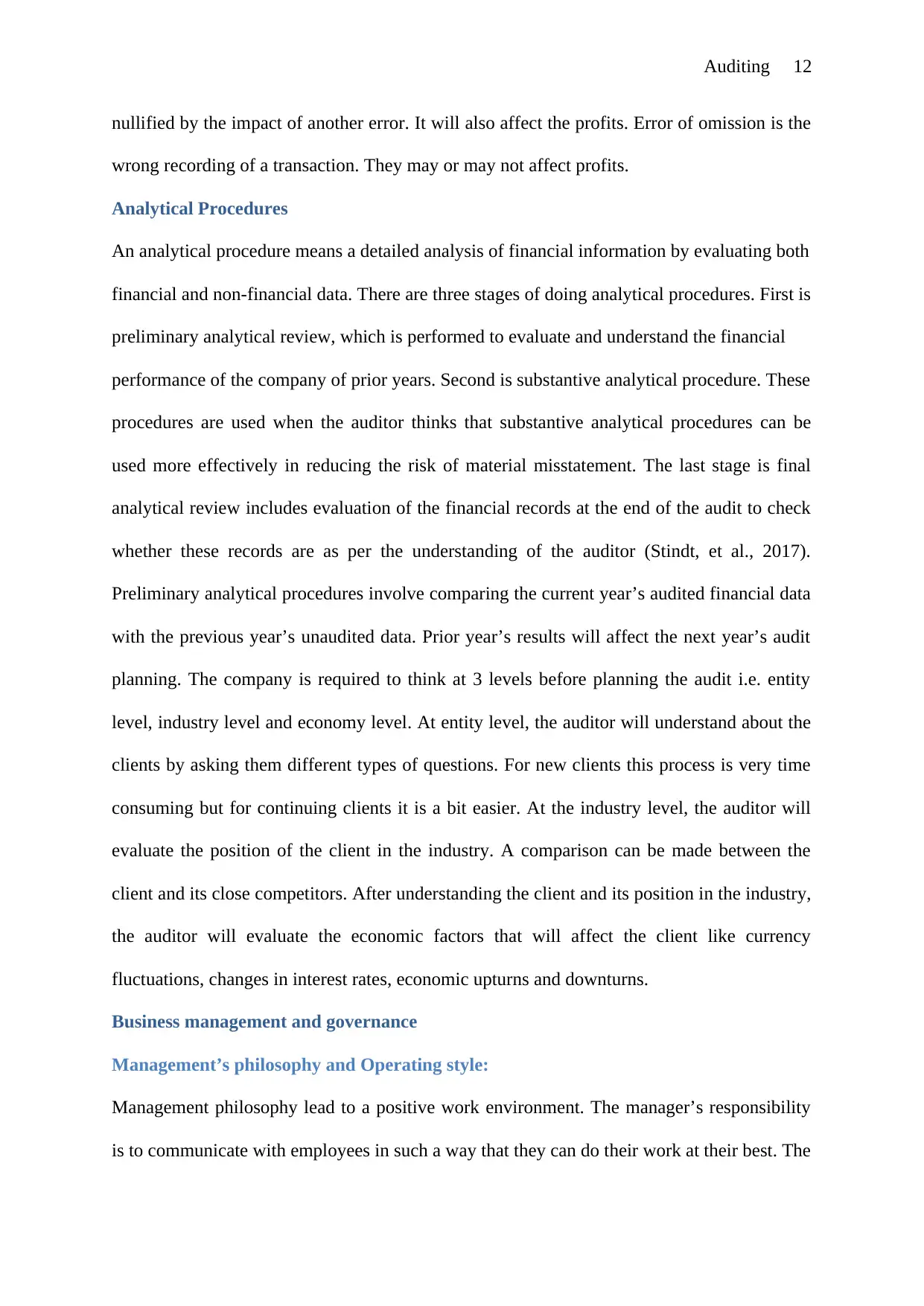
Auditing 12
nullified by the impact of another error. It will also affect the profits. Error of omission is the
wrong recording of a transaction. They may or may not affect profits.
Analytical Procedures
An analytical procedure means a detailed analysis of financial information by evaluating both
financial and non-financial data. There are three stages of doing analytical procedures. First is
preliminary analytical review, which is performed to evaluate and understand the financial
performance of the company of prior years. Second is substantive analytical procedure. These
procedures are used when the auditor thinks that substantive analytical procedures can be
used more effectively in reducing the risk of material misstatement. The last stage is final
analytical review includes evaluation of the financial records at the end of the audit to check
whether these records are as per the understanding of the auditor (Stindt, et al., 2017).
Preliminary analytical procedures involve comparing the current year’s audited financial data
with the previous year’s unaudited data. Prior year’s results will affect the next year’s audit
planning. The company is required to think at 3 levels before planning the audit i.e. entity
level, industry level and economy level. At entity level, the auditor will understand about the
clients by asking them different types of questions. For new clients this process is very time
consuming but for continuing clients it is a bit easier. At the industry level, the auditor will
evaluate the position of the client in the industry. A comparison can be made between the
client and its close competitors. After understanding the client and its position in the industry,
the auditor will evaluate the economic factors that will affect the client like currency
fluctuations, changes in interest rates, economic upturns and downturns.
Business management and governance
Management’s philosophy and Operating style:
Management philosophy lead to a positive work environment. The manager’s responsibility
is to communicate with employees in such a way that they can do their work at their best. The
nullified by the impact of another error. It will also affect the profits. Error of omission is the
wrong recording of a transaction. They may or may not affect profits.
Analytical Procedures
An analytical procedure means a detailed analysis of financial information by evaluating both
financial and non-financial data. There are three stages of doing analytical procedures. First is
preliminary analytical review, which is performed to evaluate and understand the financial
performance of the company of prior years. Second is substantive analytical procedure. These
procedures are used when the auditor thinks that substantive analytical procedures can be
used more effectively in reducing the risk of material misstatement. The last stage is final
analytical review includes evaluation of the financial records at the end of the audit to check
whether these records are as per the understanding of the auditor (Stindt, et al., 2017).
Preliminary analytical procedures involve comparing the current year’s audited financial data
with the previous year’s unaudited data. Prior year’s results will affect the next year’s audit
planning. The company is required to think at 3 levels before planning the audit i.e. entity
level, industry level and economy level. At entity level, the auditor will understand about the
clients by asking them different types of questions. For new clients this process is very time
consuming but for continuing clients it is a bit easier. At the industry level, the auditor will
evaluate the position of the client in the industry. A comparison can be made between the
client and its close competitors. After understanding the client and its position in the industry,
the auditor will evaluate the economic factors that will affect the client like currency
fluctuations, changes in interest rates, economic upturns and downturns.
Business management and governance
Management’s philosophy and Operating style:
Management philosophy lead to a positive work environment. The manager’s responsibility
is to communicate with employees in such a way that they can do their work at their best. The
⊘ This is a preview!⊘
Do you want full access?
Subscribe today to unlock all pages.

Trusted by 1+ million students worldwide
1 out of 17
Related Documents
Your All-in-One AI-Powered Toolkit for Academic Success.
+13062052269
info@desklib.com
Available 24*7 on WhatsApp / Email
![[object Object]](/_next/static/media/star-bottom.7253800d.svg)
Unlock your academic potential
Copyright © 2020–2025 A2Z Services. All Rights Reserved. Developed and managed by ZUCOL.





